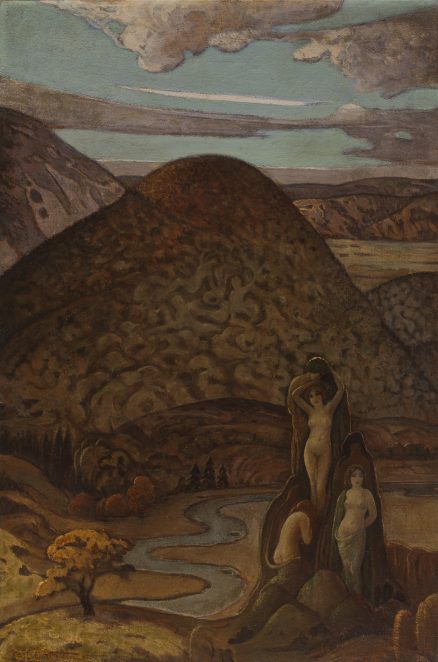- Categories
- Fantasy
- Immigrant artists
- Landscapes
- Zoom in on Artwork
- Print Page
- Email Page to Friend
Compressed into a vertical format that accentuates the dramatic contrasts of heights and valleys, Carl Wallin’s composition presents a fantasy landscape in which mountain and rocks, rendered in muted tones of dull browns, subtly reveal themselves to be composed of the forms of human bodies. The steep hills’ rounded contours and the sinuous curves of a river winding through a placid valley below mimic the sensuous figures of the nude or partly draped women who cluster at lower right to comprise a rocky outcropping. Strong outlining of the landscape features and the eccentric interpretation of cloud forms add to the dream-like effect of Wallin’s image, which evokes a natural world animated by living spirits.
This work is probably the painting Wallin exhibited as The Spirit of Alleghany in the Art Institute of Chicago’s 1928 annual “Chicago and Vicinity” exhibition. The title sheds little light on the locale ostensibly depicted, for Alleghany and its alternate spelling, Allegheny, are names associated with many places, from Alleghany County and the town of Alleghany, in southwestern New York, to the vast Allegheny mountain range, which runs through four eastern states, and western Pennsylvania’s Allegheny River. The name’s Native American origin invites romantic associations with Indian creation legends and nature-oriented spirituality. No other potentially site-specific title for a Wallin painting survives, and the artist’s travel to the eastern U.S. is undocumented. The image itself is highly generalized and idealized, forthrightly the product of the artist’s imagination rather than a document of direct experience or a specific locale.
The Spirit of Alleghany is one of many “symbolic representations” Wallin made in which clouds and other natural forms take human shape. i “I call them fantasies,” Wallin explained, “and that is what they are. They are born in my mind.”ii In the 1920s, an era in which many Americans and American artists were captivated by new developments in psychology, alternate modes of spirituality, and mysticism, several Chicago artists experimented with escapist fantasy and the female figure presented in exotic or dream-like settings complemented by a hint of eroticism. These include Claude Buck, Gerald Frank, and Indiana Gyberson, as well as Louis Grell, one of two painters with whom Wallin shared a well-received three-person exhibition at the Chicago Galleries Association in 1935. Wallin’s nature-oriented imagery is distinctive, however. Trained as an artist in his native Sweden, possibly under a decorative painter, his firm outlines and cool, diffused color evoke a Nordic sensibility, while his subject matter may reflect the influence of the nature-worship of Norse paganism. Wallin’s awareness of Sweden’s mythic past may well have been conditioned by the fame of the Vårby Hoard of Viking treasure, which was unearthed in the artist’s hometown in 1871, just a few years before his birth.
Wendy Greenhouse, PhD
Donated by M. Christine Schwartz to the Swedish American Museum, Chicago, Illinois, in 2023
i Eleanor Jewett, “Art Notes,” Chicago Tribune, Mar. 31, 1935.
ii Wallin quoted in “Fantasy Has Its Rewards in Art Show,” Southtown Economist, Feb. 24, 1933.
